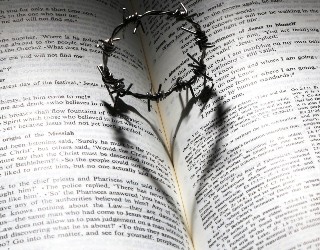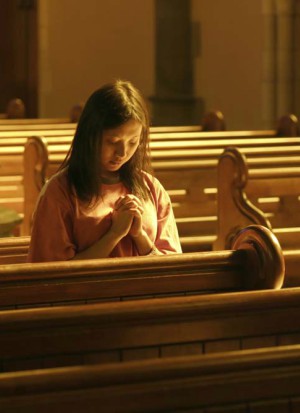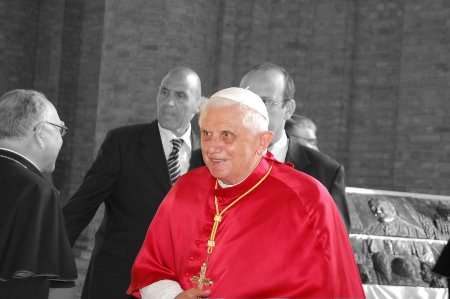We ask you, humbly: don't scroll away.
Hi readers, it seems you use Catholic Online a lot; that's great! It's a little awkward to ask, but we need your help. If you have already donated, we sincerely thank you. We're not salespeople, but we depend on donations averaging $14.76 and fewer than 1% of readers give. If you donate just $5.00, the price of your coffee, Catholic Online School could keep thriving. Thank you.Help Now >
An Artful Pope; Knights of Honor
FREE Catholic Classes
Alexander VI's Redeeming Legacy
By Elizabeth Lev
ROME, MAY 12, 2006 (Zenit) - Generally in the history of the papacy, Pope Alexander VI Borgia does not make it into the list of the top 10, 20 or 30 for that matter.
Indeed, when Alexander VI's former master of ceremonies Jacopo Burkhard decided to retire on the earnings of a tell-all book and French poet Apolloniare chose the Borgias as the poster children of his anti-clerical program in the novel "The Rome of the Borgias," Alexander became to the papacy what Nero is to the Roman empire, the Pope critics love to hate.
On April 27 the Vatican Museums unveiled the recently restored "Sala dei Misteri," or Room of Mysteries, in the Borgia apartments, the residence of Alexander VI from his election until his death in 1503. The splendid paintings by Bernardino Pinturicchio shimmering on the walls and the thoughtful iconographic program made me wonder if this could also be an appropriate occasion to pick away at the filth and grime of Alexander's reputation and see what might be revealed.
Alexander VI was born Roderigo Borgia in 1431 near Valencia, Spain. Through the offices of his uncle Pope Callistus III, he rose to cardinal, then, as favorite of Isabella and Ferdinand of Spain, he was elected Pope in 1492 -- the same year that Columbus discovered America in the employ of the same Spanish sovereigns.
We ask you, humbly: don't scroll away.
Hi readers, it seems you use Catholic Online a lot; that's great! It's a little awkward to ask, but we need your help. If you have already donated, we sincerely thank you. We're not salespeople, but we depend on donations averaging $14.76 and fewer than 1% of readers give. If you donate just $5.00, the price of your coffee, Catholic Online School could keep thriving. Thank you.Help Now >
Contemporaries viewed this election with much trepidation as all the contracts and titles related to the vast enterprise of the New World would be firmly in the hands of the Spanish. This backdrop put him in an unfavorable political light from the beginning.
The Pope himself did little to court public opinion, exasperating many by leading an openly licentious life and favoring his children, particularly Cesare Borgia, who was accused of several murders during the pontificate and protected if not abetted by his father. Alexander VI exercised his papal authority to establish a state for his dissolute son, a maneuver common to many other popes of this very temporal era.
This broad-stroke sketch of Alexander VI already hints at why many tour guides, when noting a yawn or a glazed eye, will shift the subject to the scandalous life and times of the Borgias. Many Catholics, however, end up wondering what the Holy Spirit was doing during the conclave of 1492.
This is a mystery best contemplated in the Pope's Room of Mysteries. This chamber, painted from 1493-1495 by the miniaturist-turned-painter Pinturicchio, served as an anteroom from the grand entrance hall to the papal receiving room, the Hall of the Saints. Though the pope was not only the spiritual leader of the Church but also the king of central Italy, visitors awaiting audience were not bombarded with images proclaiming his temporal authority but with seven scenes drawn from the joyful and glorious mysteries of the rosary.
The two scenes that open the cycle are the Annunciation and the Nativity. Mary and Gabriel kneel on opposite sides of a triumphal arch as God sends the Holy Spirit toward Mary. In this work, Pinturicchio uses the architectural language and decorative motifs of the Roman Empire to enhance his rendering of Christ's triumph over sin. Stately painted marbles and fine detailing add monumentality and splendor to the scene.
The Nativity scene, however, presents a marked contrast. In a dense landscape setting, with no grandiose imperial architecture in sight, Mary, Joseph, angels and shepherds gaze adoringly at the infant Christ who lies alone on the ground. No representation of an exalted king here, but the abject humility of Jesus' birth.
Instead of using fresco, Pinturicchio used a special technique to infuse his humble setting with a divine nuance. Applying paint to drywall gave him the greatest range of bright colors possible. The artist then applied plaster dots in relief all around Baby Jesus gilding them with gold leaf. The sparkle caused by light reflecting off these golden beads gives the impression of dazzling divine radiance. The shimmer of the images and the richness of the colors invited visitors to contemplate heavenly mysteries.
This complex Pope's devotion to the Virgin Mary was manifested in several ways during his pontificate. It was Alexander VI who, according to tradition, donated the first gold brought from the New World to grace the ceiling of the Basilica of St. Mary Major, and his reign saw Michelangelo receive the commission to sculpt the Pietŕ for St. Peter's Basilica.
The image of the Resurrection surmounts the door from the Room of Mysteries to the papal audience chamber, featuring Alexander VI kneeling in prayer by Christ's tomb.
Although sumptuously painted in jeweled robes, Alexander VI's hands are gently clasped and his eyes gaze adoringly upward. This would have been the image of the Pope a visitor would have before entering the throne room. Neither fiery warrior nor canny statesmen, the Pope appeared bareheaded and prayerful before Christ. One of the very clever illusionist paintings along the wall shows the papal tiara and pallium in a fictive cabinet. The implication is that the Pope divests himself of the vanities of temporal authority before the mysteries of man's salvation.
Alexander VI underwent a form of reversion after the death of his son John, duke of Gandia, in 1497 and began to promulgate long-awaited Church reforms. The Borgia Pope also added the Holy Doors to St. Peter's for the Jubilee year 1500 and wrote the prayer that is still used to open them today.
Unfortunately his sinful habits once again got the best of him and he died under somewhat mysterious circumstances. But his legacy of sinfulness left no mark in Church doctrine, while his call to conversion during the Jubilee year still remains today.
We who are fortunate enough to have lived through generations of saintly popes perhaps have a hard time understanding a time where worldly popes were more common than holy ones. It is worth noting that the Holy Spirit guided the hand of men who could have done much harm, to instead create lasting good. Moreover, Alexander VI's great grandson was St. Francis Borgia, the third Jesuit Father General and key figure in the Counter-Reformation.
Pinturicchio's transcendentally lovely work in the papal apartments suggests that rather than either delighting in or being scandalized by the sins of the popes of old, it would be better to pray for them -- and for all who are called to bear this weighty charge.
* * *
Men of Malta
While the long-suppressed Order of the Knights Templar have become a household word, thanks to Dan Brown's "Da Vinci Code," the Knights of St. John, Jerusalem and Rhodes -- today known as the Knights of Malta, who boast a millennium-old history -- are virtually unknown to our contemporaries.
Yet this order has far more of a success story, filled with fun facts, dramatic plot twists and even a happy ending. (Oh, and it also has a cameo appearance by a famous artist!)
Bernard Galimard Flavigny, a French journalist for Le Figaro, recounts this story in his book "Histoire de l'Ordre de Malte." Last Saturday, the Knights arranged a presentation of this new history of the order on their stunning terrace overlooking the Forum of Augustus, a property they have owned since the Middle Ages.
With thousands of volumes written on the order since its founder, Blessed Brother Gerard, first opened a hospice in Jerusalem in the 11th century, the first question raised was why another book on the order.
"The contemporary passion for history demands it," answered Knights of Malta spokesman Eugenio Ajroldi di Robbiate. "The book takes an interesting thematic and chronological approach to the long history of the order, but it is still a pleasant page turner for the modern reader."
Also important is accurate content. Flavigny pointed that although it packs "900 years in one volume," it took 10 years of research in Malta, Roma and Paris to write it. Flavigny studied the documents, found the facts and then told the tale.
The book contains all sorts of interesting factual nuggets about the order, such as the origin and meaning of its trademark eight-pointed cross. The white cross worn on the chest was to protect the Knights against sin and evil. The worst sanction that could be inflicted on a Knight was to lose his habit.
White symbolizes the purity of the Knight while the eight-pointed star represents the beatitudes of the Knights -- spiritual contentment, a simple life without malice, humility, penitence, love of justice, compassion, sincerity and forbearance of persecution in the name of justice.
The Knights began as hospitallers, caring for the sick, and to this day they are one of the greatest charitable medical organizations in the world. As they moved from Jerusalem to Rhodes to Malta chased by the Turkish fleet, they left in their wake sophisticated hospitals with avant-garde approaches to healing. Special diets for specific illnesses, emphasis on cleanliness, and a light and airy environment all contributed to the reputation of the Knights as healers.
Dangers to Christian pilgrims forced the order to take on new duties to protect travelers as well as defend Europe from what seemed like an inevitable invasion by the Ottoman Empire.
The order's finest military hour came May 31, 1565, when the little island of Malta occupied by the Knights was surrounded by the Turkish fleet intent on taking the island so as to have a base from which to invade Europe. The courage, self-sacrifice and incredible strategic ingenuity demonstrated by the Knights as they withheld against a three-month siege, has earned them a place in the annals of great Christian heroes.
The painter Caravaggio came to Malta in 1608 attracted by the glamorous history and spiritual humility of the Knights. After painting the extraordinary "Beheading of John the Baptist" for the order, he was offered a knighthood. But the humility that he had captured so successfully in his painting, eluded him in his personal life and, after fighting with another Knight, Caravaggio was expelled from the order.
Flavigny noted that the story of the order is permeated with its spirituality. The Knights followed the rule of St. Augustine and to this day they supply humanitarian aid worldwide, living out the same vocation begun by Brother Gerard on a far grander scale. They have continually refused to be assimilated to a nongovernmental organization so as to retain their independence and be true to their charism.
Of the more than 11,000 members today, only 100 are Professed Knights (priests). Every year in May about half the order goes on pilgrimage to Lourdes. The same charity and justice outlined by Benedict XVI in his encyclical "Deus Caritas Est" has been practiced by this order in an unbroken tradition since the 11th century.
Contact
Catholic Online
https://www.catholic.org
CA, US
Catholic Online - Publisher, 661 869-1000
info@yourcatholicvoice.org
Keywords
Pope, Knights, Honor, Alexander, Borgia, Rome
More Catholic PRWire
Showing 1 - 50 of 4,716
A Recession Antidote
Randy Hain
Monaco & The Vatican: Monaco's Grace Kelly Exhibit to Rome--A Review of Monegasque-Holy See Diplomatic History
Dna. Maria St. Catherine Sharpe, t.o.s.m., T.O.SS.T.
The Why of Jesus' Death: A Pauline Perspective
Jerom Paul
A Royal Betrayal: Catholic Monaco Liberalizes Abortion
Dna. Maria St.Catherine De Grace Sharpe, t.o.s.m., T.O.SS.T.
Embrace every moment as sacred time
Mary Regina Morrell
My Dad
JoMarie Grinkiewicz
Letting go is simple wisdom with divine potential
Mary Regina Morrell
Father Lombardi's Address on Catholic Media
Catholic Online
Pope's Words to Pontifical Latin American College
Catholic Online
Prelate: Genetics Needs a Conscience
Catholic Online
State Aid for Catholic Schools: Help or Hindrance?
Catholic Online
Scorsese Planning Movie on Japanese Martyrs
Catholic Online
2 Nuns Kidnapped in Kenya Set Free
Catholic Online
Holy See-Israel Negotiation Moves Forward
Catholic Online
Franchising to Evangelize
Catholic Online
Catholics Decry Anti-Christianity in Israel
Catholic Online
Pope and Gordon Brown Meet About Development Aid
Catholic Online
Pontiff Backs Latin America's Continental Mission
Catholic Online
Cardinal Warns Against Anti-Catholic Education
Catholic Online
Full Circle
Robert Gieb
We ask you, humbly: don't scroll away.
Hi readers, it seems you use Catholic Online a lot; that's great! It's a little awkward to ask, but we need your help. If you have already donated, we sincerely thank you. We're not salespeople, but we depend on donations averaging $14.76 and fewer than 1% of readers give. If you donate just $5.00, the price of your coffee, Catholic Online School could keep thriving. Thank you.Help Now >
Three words to a deeper faith
Paul Sposite
Relections for Lent 2009
chris anthony
Wisdom lies beyond the surface of life
Mary Regina Morrell
World Food Program Director on Lent
Catholic Online
Moral Clarity
DAN SHEA
Pope's Lenten Message for 2009
Catholic Online
A Prayer for Monaco: Remembering the Faith Legacy of Prince Rainier III & Princess Grace and Contemplating the Moral Challenges of Prince Albert II
Dna. Maria St. Catherine Sharpe
Keeping a Lid on Permissiveness
Sally Connolly
Glimpse of Me
Sarah Reinhard
The 3 stages of life
Michele Szekely
Sex and the Married Woman
Cheryl Dickow
A Catholic Woman Returns to the Church
Cheryl Dickow
Modernity & Morality
Dan Shea
Just a Minute
Sarah Reinhard
Catholic identity ... triumphant reemergence!
Hugh McNichol
Edging God Out
Paul Sposite
Burying a St. Joseph Statue
Cheryl Dickow
George Bush Speaks on Papal Visit
Catholic Online
Sometimes moving forward means moving the canoe
Mary Regina Morrell
Action Changes Things: Teaching our Kids about Community Service
Lisa Hendey
 Hi readers, it seems you use Catholic Online a lot; that's great! It's a little awkward to ask, but we need your help. If you have already donated, we sincerely thank you. We're not salespeople, but we depend on donations averaging $14.76 and fewer than 1% of readers give. If you donate just $5.00, the price of your coffee, Catholic Online School could keep thriving. Thank you. Help Now >
Hi readers, it seems you use Catholic Online a lot; that's great! It's a little awkward to ask, but we need your help. If you have already donated, we sincerely thank you. We're not salespeople, but we depend on donations averaging $14.76 and fewer than 1% of readers give. If you donate just $5.00, the price of your coffee, Catholic Online School could keep thriving. Thank you. Help Now >
Easter... A Way of Life
Paul Spoisite
Papal initiative...peace and harmony!
Hugh McNichol
Proclaim the mysteries of the Resurrection!
Hugh McNichol
Jerusalem Patriarch's Easter Message
Catholic Online
Good Friday Sermon of Father Cantalamessa
Catholic Online
Papal Address at the End of the Way of the Cross
Catholic Online
Cardinal Zen's Meditations for Via Crucis
Catholic Online
Interview With Vatican Aide on Jewish-Catholic Relations
Catholic Online
Pope Benedict XVI On the Easter Triduum
Catholic Online
Holy Saturday...anticipation!
Hugh McNichol











 Daily Readings for Thursday, April 18, 2024
Daily Readings for Thursday, April 18, 2024 St. Apollonius the Apologist: Saint of the Day for Thursday, April 18, 2024
St. Apollonius the Apologist: Saint of the Day for Thursday, April 18, 2024 Aspiration: Prayer of the Day for Thursday, April 18, 2024
Aspiration: Prayer of the Day for Thursday, April 18, 2024


